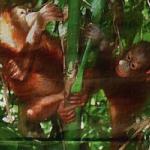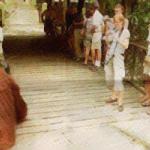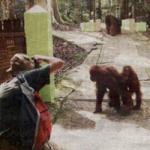Man of The Forest in Sarawak
The symphony-like sounds produced by Mother Nature's grand orchestra comprising members from the beetles, cicadas, wasps, bees, frogs, birds and other creatures of the forests provided an excellent opening the herald the arrival of a troop of semi-wild Orang Utans (Pongi pygmaeus). Sharp on the dot at 8.30 am on one crispy morning in Semenggoh Wildlife Rehabilitation Centre these shy and docile Asian apes clamber down stealthily from the crowns of trees surrounding the food platform, apparently in unison, to the strains of the beat and sounds of the forest.
The food consisting of bananas, sugar cane, nuts and milk have been neatly laid out by the wardens at 8.30am. Right on cue the Orang Utans make a quick grab for their favorite food. Some of them driven by greed resorted to all four limbs and their mouth as well to arrogate the goodies. A few of the younger ones were busy slurping milk from the bottles. After their meal they are up to their "monkey" tricks. In fact they are better at this game than their primate cousins the macaques. They have a wide repertoire of horse-play antics and in this regard they are even more ingenious and innovative than humans! Despite whatever they are doing they would respond delightfully to their names whenever the wardens call out, among others, Seduku, Delima, Ritchie, Anwar and George.
All of us standing on the raised boardwalk craned our necks towards the direction of the food platform as far as we can go against the rope-off area. They provide us with an unforgettable memory.
The Place
Semenggoh is similar in purpose and character to the world-renown Sepilok Orang Utan Rehabilitation Centre in Sandakan, Sabah. However there is a difference in that Semenggoh is also a rehabilitation sanctuary for other wildlife species such as the gibbons, monkeys, sun bears, hornbills and other wildlife which have been injured, orphaned or confiscated from illegal owners holding such creatures captive. It is very easy to get to Semenggoh as it is located in the outskirts of Kuching, the City of Cats. The Center lies 32 kilometers (22 miles) south of Kuching along the main trunk road to Serian; small town 64 kilometers (38 miles) from Kuching and Serian is well-known for the Ranchan Pools comprising a set of cascading waterfalls nearby.
Most good class hotels provide mini-vans at a small charge to Semenggoh. Taxi cabs easily available from Kuching city could also be hired at a return fare of Ringgit 60 (US$16) in addition to a levy for waiting time at the rate of Ringgit 10 (US$2.70) per hour or part thereof. For those on a tight budget or who would like to a more leisurely journey but with stops in between or who like to mingle with the locals may travel by public bus (Sarawak Transport Company Bus Numbers 6, 6A, 6B or 6C). For foreign visitors traveling in public buses they may be able to experience a veritable Tower of Babel situation as inside the bus they should be able to hear a multitude of languages and dialects ranging from Malay, English and Chinese dialects -- Mandarin, Hokkien and Foochow -- to Iban and Bidayuh spoken by the Sarawak natives.
These buses can be boarded from the STC terminus situated in the city center a short distance from the central wet market. The fare for the half hour journey is Ringgit 1.90 (50 US cents). Just tell the bus driver that you wish to visit Semenggoh and he would drop you right in front of the main outside entrance at the Forestry Department Nursery. From the main entrance visitors will need to walk an uphill for some 20 minutes along a sealed road carved out from the forest to reach the Rehabilitation Center entrance. Cars, taxi cabs and mini-buses can however drive straight to the Center entrance.
History of the Rehabilitation Center
The Center was set up in 1975 within a 740-hectare (1828-acre) forest reserve authorized in 1920 by the third White Rajah, Charles Vyner Brooke, who ruled Sarawak until 1946 when he ceded it to the British Government which turned it into a Crown Colony.
Charles Brooke in turn took over the reins of government of Sarawak when his uncle the legendary adventurer James Brooke returned in 1865 to retire before he passed away two years later. James Brooke invalidated from the British East India Company based in India arrived in Sarawak in 1839 in his well-armed schooner the Royalist. Using the sheer brute fire power of the Royalist he helped Sarawak's Viceroy (for the Sultanate of Brunei), Rajah Muda (Prince) Mahkota to bust the marauding pirates lurking in the rivers and coast-line of Sarawak as well as put down a rebellion by the local Malays and the Bidayuhs. As a reward the Sultan of Brunei installed James Brooke as the Rajah of Sarawak in September 1842.
In the early 1970s, the Government of Sarawak realized that with the destruction of vast swathes of forests due to exploitation of commercial tropical timber many wild animals had been displaced from their natural habitat and some of them had been hunted, injured or captured and retained as pets and their young ones left as defenseless orphans. This rapid despoliation of the forests started from the second half of the 1960s when the efficient killer contraption, the motorized chain saws and the mighty man-of-war of the forest, the tractors and bulldozers were deployed in commercial timber harvesting, making of jungle tracks for use by logging trucks and haulage of logs to feed the hungry saw mills in Sabah and abroad.
Until the British left Sarawak in September 1963 cutting of hardwoods was very much a localized operation as loggers had to use manual labor to cut the tree trunks, haul the logs using raw human strength to the rivers and to raft them before floating the logs down the river to the log ponds by the sea. The Semenggoh Wildlife Rehabilitation Center was therefore established with the objective of training injured, orphaned or confiscated wild animals and birds so that they could be equipped with the skills and the experience to be able to survive on their own in the wilds of Sarawak.
The Wildlife Found in the Rehabilitation Center
The star attraction is of course the Orang Utan, the great Asian ape. The intelligence of the huge and gentle being and its remarkably human expression make it a source of endless fascination. Apes due to their ability to walk with a human-like gait and their human size body structure as well as their human-looking face (albeit with a protruding jaw) are much loved by many humans. In fact their name is literally translated as the Man of the Forest from Malay/Indonesian. The adult male Orang Utan is 1.4 meters (4.5 feet) in height and weighs 100 kilograms (220 pounds). The adult female however is shorter and lighter. Unlike Man and the other animals the Orang Utan builds its "nests" every day to stay sheltered for the night. Their "nest" is a rough platform of twigs, leaves and branches pulled over the crotch of strong branches high up in the crown of trees.
In the Rehabilitation Center the new arrivals after medical attention and quarantine are brought daily by wardens to the forest and encouraged to climb trees, swing from branch to branch, and forage for food such as fruits, termites and other invertebrates and young shoots of rattans and palms. They are also taught to identify those poisonous fruits which are inedible to Orang Utans. Most Orang Utans are able after two to three years to be gain back their instinct to enable them to survive on their own in the forests.
The best times for visitors to visit the Center is their feeding time which is 8.30am to 9.00am and 2.30pm to 3.00pm. The morning session is recommended as the temperature should be around 26 degrees Celsius (78 degrees Fahrenheit) as opposed to 32 degrees Celsius (89 degrees Fahrenheit) in the mid-afternoons. Not all the Orang Utans come to the feeding platform as those who are capable of foraging for food on their own would give the free meals a miss. This would demonstrate the success of Semenggoh as a Rehabilitation Center if more and more Orang Utans do not show up at feeding times. When the fruits are not in season then more of these animals would turn up. Therefore it depends on luck and the seasonality of fruiting to be able to see the Orang Utans as they are not kept in cages and shown as exhibits as in a zoo.
Feeding times offer visitors a chance of viewing the Orang Utans at close range for a long period of time. It also offers a unique wildlife experience and excellent photo taking opportunities. After half an hour when they are well-fed and tired after messing around with one another or with the wardens or even with tourists who happen to be in their way they would in the same way they made their appearance quietly and unobtrusively leave from the scene. And that's the end of the show for the time being!
Another animal which is often sent to the Center for rehabilitation is the Mueller's Gibbon or Bornean Gibbon (Hylobates muelleri). The gibbons are hunted for food by the natives who are the Ibans, Bidayuhs, and the Orang Sungei or "Interior Peoples" who comprise smaller native communities such as the Penans, Punans, Kajangs, Kayans and Kenyahs. The coastal Malays because of their Islamic faith which discourages eating animals with either sharp teeth or claws shun such meat. However many of the natives like to keep gibbons as pets as they often make endearing pets although keeping them is an illegal practice. Gibbons are highly territorial by instinct. A troop consists of a nuclear family and it is common to find maturing adolescents (seven to eight year-olds) being chased off from the family. These young adolescent gibbons must therefore carve out a territory of their own often on the fringes of established families.
Consequently displaced gibbons especially inexperienced young males find it difficult to establish themselves. Field studies have found that the mortality rate of gibbons undergoing rehabilitation is quite high as they often die from loneliness, disease, starvation or are killed by hunters.
Like the Orang Utans, gibbons are apes as they too are tail-less but they are half the size of the larger apes. The Bornean Gibbons are silvery grey furry animals with black limbs and black faces but with a streak of white above the eyes. Unlike the Orang Utans the gibbons are very adept at swinging from branch to branch effortlessly using their long and slender arms in a pendulum-like fashion which is referred to as brachiating. Similar movements of the Orang Utans are slower and jerky. The other protected wildlife which are currently being rehabilitated in the Center are the different types of monkeys, sun bears (Helarctos malayanus), white-bellied sea eagles (Haliaeetus leucogaster) and some of the eight species of hornbills found in Borneo including the rhinoceros hornbill (Buceros rhinoceros) which is the state emblem of Sarawak.
However the Center is not only a haven for the displaced wildlife. There is a fruit garden with many of the wild fruit trees found in the jungles of Borneo. It also houses an ethnic botanic garden containing herbs (many of traditional medicinal value) and spices such as turmeric and lemongrass planted by Sarawak Malays and wild ginger by the Bidayuhs. The Sarawak Biodiversity Center, a botanical research center, a seedling center as well as a seed bank are also located in the Center.
Why Visit Semenggoh Wildlife Center?
The Center not only offers visitors an opportunity to be up close with Orang Utans and other wildlife in their natural environment but also a place to savor the peace, tranquility and quietude afforded by primal, pristine forest reserve. More importantly it educates the public to be more aware of the effects of wanton destruction of the habitat of wildlife arising from commercial exploitation of natural resources. It is of vital importance that governments and the people are constantly reminded that Man must learned from the extinction of the Bali Tiger (Panthera tigris balica) -- the last one was killed in 1937 -- and the Java Tiger (Panthera tigris sondaicus) -- last seen in the wilds in 1972. Already the one-horned Java Rhinoceros (Rhinoceros sondaicus) which has suffered from extensive clearance of forest and relentless hunting is in danger of extinction soon. Similarly the two-horned Sumatran Rhinoceros (Dicerohinus sumantrensis) is also highly endangered as it is seriously threatened by excessively high demand for its horn and other organs as an aphrodisiac.
Therefore the invaluable work of the Semenggoh Wildlife Rehabilitation Center towards Mankind and our children must be appreciated and supported by all right thinking man and woman. We do not relish showing to our children or grandchildren only the Orang Utan specimens exhibited in some musty museum nor rifle deep below our drawers to retrieve old photo albums to show them badly faded photographs of such wild animals. We wish the Center every success in its endeavors.
* * * * *
 ThingsAsian
ThingsAsian



















